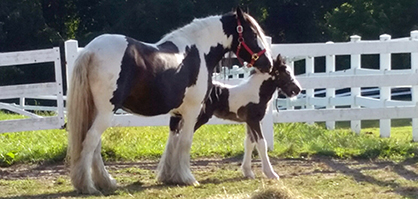Retained Placenta Causes Post-Foaling Emergency
New Bolton Center Field Service Team Solves Post-Foaling Emergency
Penn Vet Extra by: Louisa Shepard
“We have worked with Ashley for so many years,” Saunders said. “I was confident Tegan would be in good hands.”
1-2-3
When Boyle arrived at about 9:30 am that August morning, three hours after the birth, the placenta was “very retained.”
“We talk about 1-2-3: the foal should stand within 1 hour, should be nursing within 2 hours, and the placenta should pass by 3 hours,” Boyle said. “Call your vet if those things aren’t happening. Usually they happen sooner, but that’s the longest you should wait.”
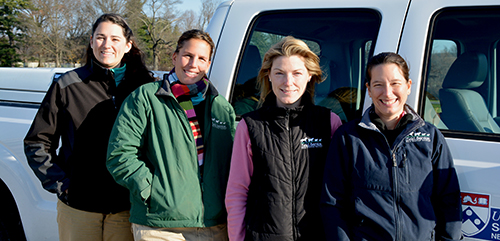 The timing is crucial on the placenta passing, because mares can get septic shock as the tissue starts to degrade in the uterus. “Bacteria can get into the bloodstream and also release inflammatory factors, and the horse can develop laminitis within a day,” Boyle said. “It is a life-threatening condition if you don’t get the placenta out.”
The timing is crucial on the placenta passing, because mares can get septic shock as the tissue starts to degrade in the uterus. “Bacteria can get into the bloodstream and also release inflammatory factors, and the horse can develop laminitis within a day,” Boyle said. “It is a life-threatening condition if you don’t get the placenta out.”
Working with a fourth-year Penn Vet student and a veterinary technician, Boyle conducted a full examination on the 13-year-old mare. “Her vitals were normal. She was eating. She had milk. All of those things were good,” she said.
But an examination of the amnion remaining after the foal was born confirmed that the placenta had not passed. “We knew the entire placenta was in her uterus.”
Boyle administered two doses of Oxytocin to cause the mare’s uterus to contract. Plus she gave some sedation to help with the pain of the cramps.
Checking the Foal
While the mare lay down, Boyle and the team turned their attention to the foal, conducting a full exam. Named Sir Arthur, a nod to his mother’s birthplace in the United Kingdom, the foal was making an unusually loud respiratory gurgling sound.
“I did not see milk coming out of his nose, but the noise indicated he wasn’t swallowing properly,” Boyle said. So she called to consult with Dr. Jonathan Palmer, Director of New Bolton Center’s Neonatal Intensive Care Unit.
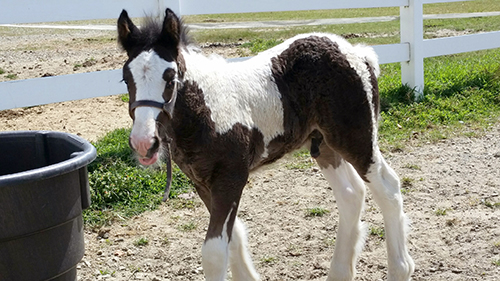 “Dr. Palmer thought it was possible the foal was retaining milk within the esophagus, and as he matured and got stronger over the first week, this should subside,” she said. “Our plan was to start the foal on antibiotics to prevent pneumonia and monitor his physical exam findings and bloodwork closely.”
“Dr. Palmer thought it was possible the foal was retaining milk within the esophagus, and as he matured and got stronger over the first week, this should subside,” she said. “Our plan was to start the foal on antibiotics to prevent pneumonia and monitor his physical exam findings and bloodwork closely.”
Still Stuck
After working with the foal, Boyle checked on Tegan. The placenta still had not passed or even made much progress. Boyle decided to conduct a lavage, a procedure to infuse warm, sterile saline solution through a tube inserted by hand into the mare’s uterus. The goal is to have the liquid separate the placenta from the uterus.
“We let the fluid do its work,” Boyle said, and the placenta started to appear slowly, to the mare’s hocks, then fetlocks, until the first of two uterus “horns” appeared and then…it got stuck. Boyle siphoned the lavage fluid out, but the placenta was still in.
At noon, a second, five-liter bag was prepared. Everyone pitched in—the student, the vet tech, the barn staff. “I was turned the other way, and I heard a ‘plop.’ There were cheers all around,” Boyle said.
“It had been in there a good, long time,” Saunders said. “We all did a ‘Hooray!’”
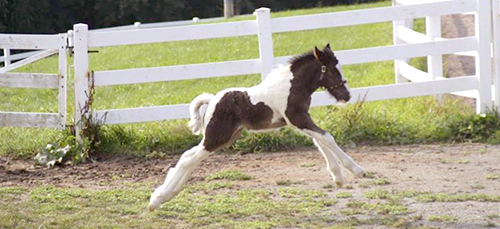 Luckily, the placenta did not tear, which is always a risk. Even so, they laid it out to make sure all of the pieces were there. The foal usually is in one of the two “horns” of the uterus, which create a “Y” shape. Often left behind in the uterus is the “nongravid horn,” the one the foal did not occupy.
Luckily, the placenta did not tear, which is always a risk. Even so, they laid it out to make sure all of the pieces were there. The foal usually is in one of the two “horns” of the uterus, which create a “Y” shape. Often left behind in the uterus is the “nongravid horn,” the one the foal did not occupy.
“It came out totally intact,” Boyle said. “You always want to find the tips of the horns to make sure it is all there.”
Boyle administered another lavage with five liters of saline. They administered IV antibiotics, medication that continued for the next several days.
Why does the placenta not pass? “There is some preexisting condition in the mare that predisposes her to experience a retained placenta,” Boyle said. “Often it is associated with a difficult birthing, although this mare did not have any other evidence of a dystocia (abnormal foaling).”
Field Service Team Follow-Up
The following morning, Dr. Meagan Smith of Field Service returned to check on the pair. An analysis of the colt’s blood showed that he was getting plenty of colostrum, essential for building the immune system. He continued to nurse well, and the noise in his lungs started to fade within the first few days. To be safe, Penn Vet’s experts kept him on antibiotics for a full two weeks.
The mare had a bit of a fever, so she was treated with a nonsteroidal medication, similar to ibuprofen for people. Boyle returned to examine the pair a few days later, and the fever was gone. But a sonogram showed a bit of fluid that looked like it could be an infection in the uterus.
Dr. Jennifer Linton, a reproduction specialist on the Field Service team, came out to perform an exam. Although the uterus appeared to be healthy, the mare’s blood analysis showed her fibrinogen level was higher than normal, indicating an infection. Linton decided to keep the mare on oral antibiotics for two weeks.
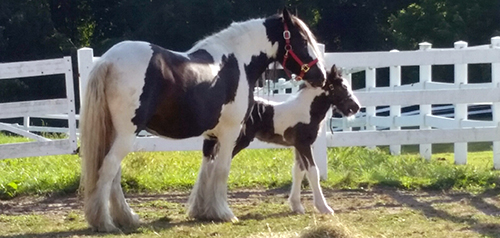 “We have everything on the Field Service truck that we need to treat the majority of a horse’s problems,” Boyle said. Collectively, the Equine Field Service section has four digital radiograph units, four ultrasound units, two different video endoscopes, two dental powerfloats, and a temperature-controlled storage box for medications.
“We have everything on the Field Service truck that we need to treat the majority of a horse’s problems,” Boyle said. Collectively, the Equine Field Service section has four digital radiograph units, four ultrasound units, two different video endoscopes, two dental powerfloats, and a temperature-controlled storage box for medications.
New Bolton Center’s Equine Field Service team regularly serves farms within about a 30-mile radius of the campus in Kennett Square, PA.
“We have a great group of clinicians in the field, all four of us with additional specialized training, and we enjoy working as a team to keep our patients healthy,” Boyle said. “In addition, we are an extension of the hospital, with a direct line to further consultations if needed.”
Part of the Carousel Crew
Sir Arthur joins Angus, who they call Carousel Jewels, a gelding born in July 2014 – same sire, different dams.
The horses are both destined for riding lessons, including a therapeutic program, at the Equestrian Center. “They are very well-mannered,” Saunders said.
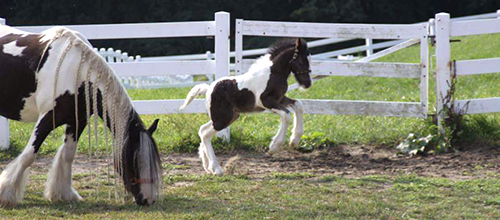 Tegan, a gorgeous black-and-white mare whose breed is in the Draft Horse family, stands 15-2 hands. Jewels stands 14-3, and Sir Arthur is already close to 13 hands at five months old.
Tegan, a gorgeous black-and-white mare whose breed is in the Draft Horse family, stands 15-2 hands. Jewels stands 14-3, and Sir Arthur is already close to 13 hands at five months old.
Mare and foal are out all day, along with several other animals. The Center has 35 horses, including 10 that are part of the Mounted Police force, as well as donkeys, ponies, goats, alpacas, sheep, chickens, tortoises, and peacocks.
Of Sir Arthur, Saunders says, “He’s coming along very well. He’s very healthy, with a good appetite.”










